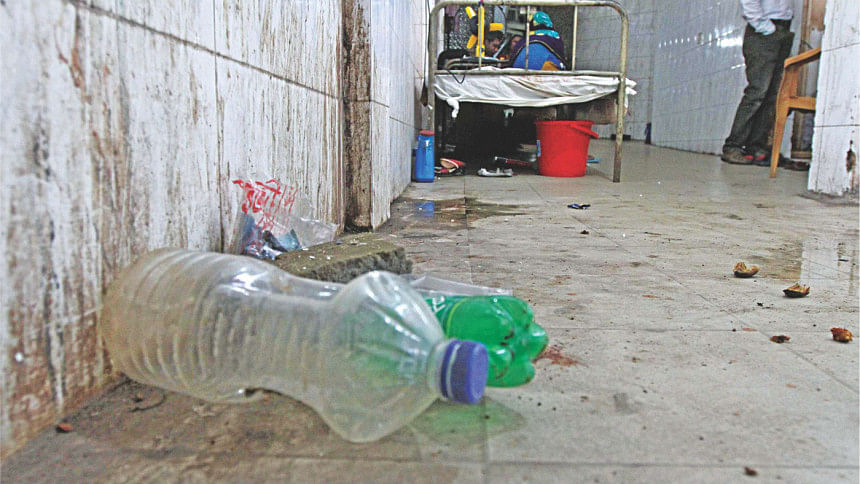Not a good place for the sick

Seventy-year-old Elahi Nawaz with a broken thighbone was lucky to get some 'room' for admission in a filthy abandoned space at the country's biggest public hospital attached to Dhaka Medical College.
It is a 70-square-foot tiny room with an abandoned toilet where he was accommodated in the early hours of August 27 for a long wait for surgery.
Another patient, 35-year-old Monirul Haq with motorbike accident injuries from Boalmari in Faridpur also found his place in the room crammed with two medical beds.
As a result, the small room turned crowded with two patients and three of their attendants.
The four walls and the adjoining corridor-like passage of the room are awfully filthy with yellowish sticky layers, while the floors smeared with dirt.
“My husband is unable to go to the toilet at the other end of the corridor. His defecation is done with a chair just a little away,” said Hanufa, Elahi's wife, adding, “His urination is done in polythene bags in the room.
“In fact, we have no other alternatives,” she said, adding that the attached toilet had no water and its doors were closed with a piece of string.
Elderly Elahi, a private security guard in Khilgaon in the capital, has been waiting in this condition for more than one and a half months.
The duty physician said they expected to do the operation by mid-October, said Hanufa.
“It is claustrophobic, filthy, abominable and infectious,” said Monirul's father Enamul Haq. “The condition is so terrible that I am worried we might get infected by any diseases.”
He said he along with his wife and son had to travel all the way to Dhaka Medical College Hospital (DMCH) for treatment, as Faridpur Medical College Hospital lacks an intensive care unit.
The room and its adjoining narrow stretch of corridor remain an isolated area that altogether accommodates five medical beds as part of ward No-103 without any identification number.
A stack of rusting junks of medical beds and metal stuffs piled in front of the Casualty Operation Theatre and a clinical waste bin are what welcomes one, who may proceed to the isolated area through a narrow access.
The room and the adjoining approach passage to the hospital building were once a part of the emergency unit nearly one and a half decades ago, said insiders.
The approach passage has been turned into a narrow stretch of corridor to accommodate three beds.
Assistant Director Khaza Abdul Gafur attributed the awful state of cleanliness to “lack of manpower” without saying what the exact requirement for manpower is and what they have.
Officially, the number of medical beds at the hospital has increased to 2,600 from 1,800 over the past two and a half years. However, the actual number of staying patients ranges from 3,300 to 3,500 on average due to enormous rush at a time, he added.
“But the manpower required for maintaining cleanliness has not increased proportionately and it remains the same as it was for 1,800 patients,” he said.
The additional patients are accommodated on the floor, in the corridor and sometimes two patients are crammed on a single bed, Gafur informed.

 For all latest news, follow The Daily Star's Google News channel.
For all latest news, follow The Daily Star's Google News channel. 



Comments